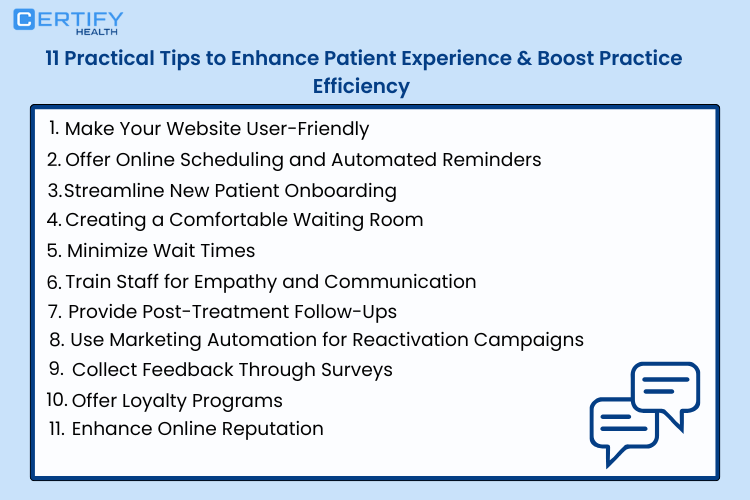Introduction
Missed appointments cost the U.S. healthcare system $150 billion annually, with a physician losing over $150,000 each year. This staggering statistic represents just one consequence of operational inefficiencies which results in not only poor patient experience and poor patient care but also big revenue loss.
Today’s healthcare success depends on three critical factors:
- Power of personalization that creates emotional connections between patient and provider through meaningful interactions and accessible communication;
- Optimizing the complete patient care journey across all touchpoints, from online scheduling through post-treatment follow-up;
- Eliminating burdensome manual process in healthcare that create long wait times, paperwork backlogs, and staff burnout.
When practices address these areas simultaneously, they don’t just enhance patient experience—they build more profitable, sustainable businesses.
Modern healthcare demands a thoughtful approach to every patient interaction, transforming practices from clinical facilities into patient care environments where efficiency and compassion coexist.
How Poor Patient Experience Impacts a Healthcare Practice
Decline in Patient Retention & Loyalty

A poor patient care quality results in poor patient experience and has a direct impact on the viability of the practice in a number of ways. Long wait periods, impersonal service, and communication breakdowns significantly reduce patient retention.
Consider that while 60-70% of patients return to providers after receiving quality care, 30-40% may switch providers even after satisfactory treatment. This figure illustrates how fragile patient loyalty can be, particularly when competitors provide more efficient, personalized services. Every patient who moves to another provider implies lost lifetime value as well as extra acquisition expenses.
Negative Online Reviews & Reputation Damage

A practice’s reputation can be completely destroyed by negative online reviews brought on by a poor patient experience. Before making an appointment, potential patients usually check online ratings & reviews in today’s digital-first healthcare search environment.
Negative online reviews describing lengthy waits, rude staff, or billing confusion can deter dozens of potential new patients. This reputation damage compounds over time, requiring significant investment to repair once established.
Revenue Loss & Decreased Appointment Bookings
The revenue loss goes beyond fewer appointments. When they face bad experiences in patients care journey, they are less likely to stick to their appointments, which usually results in greater no-show rates.
Studies demonstrate that practices using automated reminders have seen significantly reduced no-show rates, with research indicating that combining text and email reminders can reduce no-shows by up to 30%. These missed appointments create unfilled schedule gaps that directly impact daily revenue.
Increased Administrative Burden & Staff Burnout

More administrative work from handling grievances, clearing up misunderstandings, and responding to negative reviews takes away staff’s time from more productive endeavors.
Teams that must continuously deal with patient complaints in addition to their regular duties results in increased staff burnout. In addition to further upsetting patient relationships, this cycle results in increased turnover and higher training and recruitment expenses.
Higher Patient Acquisition Costs

Higher patient acquisition costs present another financial challenge stemming from poor patient experience. Marketing to replace departing patients costs significantly more than retaining existing ones.
Practices with reputation damage must spend more on advertising to overcome negative perceptions, further straining budgets. The cost of acquiring a new patient can be five to ten times higher than retaining an existing one, making patient retention strategies crucial to cut costs related to patient acquisition and promote financial sustainability.
Legal & Compliance Risks

Poor patient experience often correlates with increased legal and compliance risks. Dissatisfied patients are more likely to file formal complaints or pursue legal action.
Additionally, rushed patient care interactions and documentation errors resulting from inefficient processes can lead to legal and compliance risk. These issues not only create financial liability but also consume significant administrative resources to address.
Practices with systematic approaches to patient care typically report fewer legal challenges and compliance concerns.
11 Practical Tips on How to Enhance Patient Experience & Boost Practice Efficiency

First Impressions Matter
1. Make Your Website User Friendly
Believe it or not but it is true that first impression matters. Make your website user friendly by ensuring it reflects the quality and professionalism of your practice. A mobile-responsive, easily navigable website serves as your digital front door, often forming patients’ first impressions. Include online booking functionality, clear directions, insurance information, and frequently asked questions to reduce phone inquiries.
Healthcare providers increasingly recognize that user-friendly websites not only attract new patients but also reduce front-desk workload by enabling self-service for common needs. Invest in a professional design that loads quickly and presents information clearly across all devices.
2. Offer Online Scheduling and Automated Reminders
Offer online scheduling and automated reminders to modernize your practice operations. Enabling patients to book or reschedule appointments online reduces phone traffic and administrative time while providing the convenience patients increasingly expect. Automated reminders via email or text have proven remarkably effective at reducing no-shows.
CERTIFY Health’s patient scheduling software is one such technology your practice should adopt; it can reduce no-show rates by streamlining the scheduling process in healthcare and impact your revenue by keeping your schedule full.
3. Streamline New Patient Onboarding
Streamline new patient onboarding by digitalizing intake forms that patients can complete before their visit. Digital patient intake and patient registration save receptionists significant time previously spent manually transcribing handwritten patient details into practice management systems.
This approach minimizes data entry errors while accelerating the check-in process. Patients appreciate completing forms at their convenience rather than rushing through paperwork in waiting rooms. Electronic forms also improve documentation quality by eliminating illegible handwriting issues that can lead to errors in patient care.
CERTIFY Health’s patient intake software enables practices to digitize patient intake form, build forms that are HIPAA compliant and allow patients to complete these forms on mobile, desktop, or kiosk reducing administrative burden for your staff. Also, it cut costs spent on papers, printers, etc., saving cost and time, ensuring smooth operations.
Elevating the In-Office Experience
4. Creating a Comfortable Waiting Room
Creating a comfortable waiting room transforms what could be a stressful wait into a more pleasant experience. Therefore, elevate in-office experience by considering elements like natural lighting, comfortable seating arranged for privacy, and appropriate entertainment options like Wi-Fi access or health education materials.
Temperature control, cleanliness, and accessibility features demonstrate attention to detail that patients notice. A thoughtfully designed waiting area minimize waiting times and anxiety while establishing expectations for the quality of care to follow.
5. Minimize Wait Times
Minimize waiting time by implementing efficient scheduling practices and keeping patients informed about delays. Long waits consistently rank among patients’ top complaints and significantly impact patient care and satisfaction.
CERTIFY Health’s patient engagement platform provides accurate wait time estimates and helps set appropriate expectations. When delays occur, prompt communication showing respect for patients’ time can preserve goodwill despite the inconvenience.
Practices that successfully minimize waiting time achieve patient higher satisfaction scores and get fewer negative online reviews focused on operational aspects.
Personalizing Patient Care
6. Train Staff for Empathy and Communication
Train staff for empathy and communication by investing in regular professional development focused on patient interaction skills. Front desk staff serve as the face of your practice and significantly influence patient perceptions.
Ensure team members understand the power of personalization, warm greetings, active listening, and compassionate responses to concerns in patient care. Role-playing exercises can help staff develop empathetic approaches to common scenarios like insurance confusion or appointment delays.
Establishing clear communication protocols ensures consistent patient care experiences regardless of which team members patients encounter.
7. Provide Post Treatment Follow Ups
Provide post-treatment follow-ups to extend personalized patient care beyond the office visit. Automated yet personalized emails or texts with aftercare instructions demonstrate ongoing concern for patient wellbeing.
This approach improves treatment adherence while creating additional touchpoints that strengthen the provider-patient relationship. Follow-up communications also provide natural opportunities to request feedback, helping identify and address concerns before they escalate to negative reviews.
CERTIFY Health’s patient communication platform enables two-way communication, making communication easy for patients and providers. Send reminders to patients, connect with them to discuss health outcomes, share reports, etc., and provide after-work hour support and post-treatment follow-ups.
Retention Through Engagement
8. Use Marketing Automation for Reactivation Campaigns
Use marketing automation for reactivation campaigns targeting patients who haven’t visited recently. Personalized communications highlighting new services, preventive care reminders, or seasonal health tips keep your practice top-of-mind.
These outreach efforts often yield excellent returns by bringing established patients back and lowering new patient acquisition costs. Segmented campaigns based on patient history and needs demonstrate attention to individual circumstances that patients appreciate.
CERTIFY Health equips you with tools to leverage the power of personalization and target patients through broadcast messages and emails. It is a very useful tool for retaining or attracting new customers by sending personalized messages, reminders, etc.
9. Gather Feedback Through Surveys
Gather feedback through surveys distributed at strategic points in the patient care journey to increase your online reputation and also understand patient concerns. Brief, focused questionnaires after appointments provide actionable insights into specific experiences, while annual comprehensive surveys help identify broader trends.
Digital tools like CERTIFY Health enable real-time feedback collection, helping you to know patients’ concerns and offer quick resolution when issues arise.
Practices that systematically gather feedback and visibly implement improvements based on patient input demonstrate commitment to continuous enhancement. This approach also identifies operational inefficiencies that might otherwise go unnoticed by management.
10. Offer Loyalty Programs
Offer loyalty programs that recognize and reward patient retention and referrals. Consider service discounts, priority scheduling, or partnerships with local wellness businesses to provide added value. These programs acknowledge patients’ ongoing trust while incentivizing continued relationships.
Some practices successfully implement tiered programs offering increasingly valuable benefits based on relationship longevity or service utilization. Beyond the direct benefits to patients, these programs create positive differentiation from competitors, focusing solely on clinical services.
11. Enhance Online Reputation
Online reputation includes your social media and Google My Business, where people have reacted – liked, shared, and commented about you. The perception builds in the patient’s mind looking at your online reviews can make or break your reputation.
Therefore, it is important for you to enhance your online reputation to retain or gain new patients. You can improve your online reputation by actively requesting reviews from your satisfied patients following positive experiences.
Develop a systematic approach to review generation that makes leaving feedback simple and convenient. Respond thoughtfully to all reviews—both positive and negative online reviews—demonstrating engagement and commitment to improvement.
A strong online reputation attracts new patients while reinforcing existing patients’ confidence in their provider choice. Research indicates that practices with robust review management strategies typically outperform competitors in new patient acquisition.
Conclusion
The strategies outlined above collectively improve patient care while simultaneously addressing the fundamentals of reducing costs and increasing revenue in healthcare landscape
Practices can implement these approaches on how to enhance patient experience and see multiple benefits, such as increased patient loyalty, patient acquisition, enhanced online reputation, higher appointment volume, improved staff satisfaction and retention, and strengthened market position.
Leverage digital tools like CERTIFY Health to simultaneously enhance the patient experience while streamlining administrative functions. When front desk operations run smoothly, clinical teams can focus entirely on delivering outstanding patient care without administrative distractions.
Book a Demo today to see the impact of digital tools to improve patient care, cut costs, and improve efficiency.











